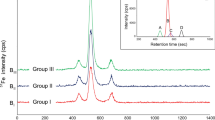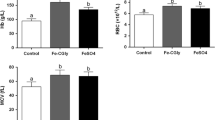Abstract
Male ICR mice were either given water containing Cd at a level of 192–200 ppm for 45 days (ingestion group), or were injected subcutaneously once a week with Cd (1 mg/kg) as CdCl2 for 7 weeks (injection group). The control group was given Cd-free water. In both Cd groups, the hematocrit and hemoglobin values did not change markedly. In the ingestion group, the Fe concentration decreased greatly in the liver, kidney, spleen, and duodenum. These decreases may be due to depression of Fe absorption from the intestine. In the injection group, Fe increased in the liver, spleen, and duodenum, although it decreased in the kidney. By Sephadex G-200 gel filtration, Fe-proteins in the hepatic supernatants were located in the void volume region of this gel column in both Cd groups. Apparently, Fe was not a component of metallothionein (MT) protein. The hepatic MT induction by Cd resulted in an increase in hepatic supernatant Cu. Serum Cu and ceruloplasmin (Cp) activity were stimulated only in the injection group. The enhancement of Cp activity may possibly be due to the increase in hepatic Cu which was accompanied by an increase in hepatic Fe, rather than a decrease. Our observations suggest that Fe metabolism is influenced differentially by the administration route of Cd.
Similar content being viewed by others
References
Ashby SL, King LJ, Parke DVW (1980) Effect of acute administration of cadmium on the disposition of copper, zinc and iron in the rat. Environ Res 21: 177–185
Axelsson B, Piscator M (1966) Serum proteins in cadmium poisoned rabbits with special reference to hemolytic anemia. Arch Environ Health 12: 374–381
Berlin M, Friberg L (1960) Bone marrow activity and erythrocyte destruction in chronic cadmium poisoning. Arch Environ Health 1: 478–486
Berlin M, Piscator M (1961) Blood volume in normal and cadmium poisoned rabbit. Arch Environ Health 2: 576–583
Cousins RJ, Barber AK, Trout JR (1972) Cadmium toxicity in growing swine. J Nutr 103: 964–972
Drabkin DL, Austin JH (1935/1936) Spectrophotometric studies II. Preparations from washed blood cells; nitric oxide hemoglobin and sulfhemoglobin. J Biol Chem 112: 51–65
Evans JL, Abraham PA (1973) Anemia, iron storage and ceruloplasmin in copper nutrition in the growin rat. J Nutr 103: 196–201
Freeland JH, Cousins RJ (1973) Effect of dietary cadmium on anemia, iron absorption and cadmium binding protein in the chick. Nutr Reports Internat 8: 337–347
Frieden E, Hsieh HS (1976) Ceruloplasmin; the copper transport protein with essential oxidase activity. Adv Enzymol 44: 187–235
Hamilton DL, Valberg LS (1974) Relationship between cadmium and iron absorption. Am J Physiol 227: 1033–1037
Lowry OH, Rosebrough NJ, Farr AL, Randall RJ (1951) Protein measurement with the Folin phenol reagent. J Biol Chem 193: 265–275
Mills CF (1980) Metabolic interactions of copper with other trace elements. In: Biological roles of copper. Excerpta Medica, Amsterdam/Oxford/New York, pp 49–69
Osaki S, Johnson DA, Frieden E (1971) The mobilization of iron from the perfused mammalian liver by a serum copper enzyme, ferroxidase I. J Biol Chem 246: 3018–3023
Prigge E (1978) Early signs of oral and inhalation cadmium uptake in rats. Arch Toxicol 40: 231–247
Prigge E, Baumert HP, Muhle H (1977) Effects of dietary and inhalative cadmium on hemoglobin and hematocrit in rats. Bull Environ Contam Toxicol 17: 585–590
Ragan HA, Nacht S, Lee GR, Bishop CR, Cartwright GE (1969) Effect of ceruloplasmin on plasma iron in copper-deficient swine. Am J Physiol 217: 1320–1323
Ramsay WNM (1957) The determination of the total iron-binding capacity of serum. Clin Chim Acta 2: 221–226
Sabbioni E, Marafante E (1975) Heavy metals in rat liver cadmium binding protein. Environ Physiol Biochem 5: 132–141
Schosinsky KH, Lehman HD, Beeler MF (1974) Measurement of ceruloplasmin from its oxidase activity in serum by use of o-dianisidine dihydrochloride. Clin Chem 20: 1556–1563
Stonard MD, Webb M (1976) Influence of dietary cadmium on the distribution of the essential metals copper, zinc and iron in tissues of the rat. Chem Biol Interact 15: 349–363
Stowe HD, Goyer RA, Medley P, Cates M (1974) Influence of dietary pyridoxine on cadmium toxicity in rats. Arch Environ Health 28: 209–216
Sugawara N (1977) Influence of cadmium on zinc distribution in the mouse liver and kidney: role of metallothionein. Toxicol Appl Pharmacol 42: 377–386
Sugawara N, Sugawara C (1984a) Effect of silver on ceruloplasmin synthesis in relation to low-molecular-weight protein. Toxicol Lett 20: 99–104
Sugawara N, Sugawara C (1984b) Comparative study of effect of acute administration of cadmium and silver on ceruloplasmin and metallothionein: involvement of disposition of copper, iron and zinc. Environ Res (in press)
Author information
Authors and Affiliations
Rights and permissions
About this article
Cite this article
Sugawara, N., Sugawara, C. & Miyake, H. Effects of subcutaneous and oral cadmium on iron metabolism: Role of ceruloplasmin and metallothionein. Arch Toxicol 56, 25–28 (1984). https://doi.org/10.1007/BF00316347
Received:
Accepted:
Issue Date:
DOI: https://doi.org/10.1007/BF00316347




